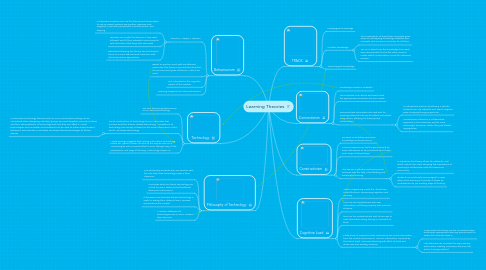
1. Technology
1.1. The two technology theories are SCOT and media ecology
1.2. Social Construction of technology (SCOT) advocates that humans and their actions dictate technology. Acceptance of technology into society is based on the social interactions of the world. We shape technology
1.2.1. In education technology theories such as SCOT and media ecology can be considered when designing activities; groups can work together reconstruct ideas and their interpretations of technology and how they can affect it. Social technologies such as twitter and Facebook can be used to either shape student behaviour and activities or students can shape those technologies to fit their desires
1.3. Media Ecology suggests that coding information, technology, media etc. govern human life due to the way we react to it. Technologies such as media affect human feelings, way of life, perceptions, and ways of thinking. Technology shapes us.
2. Behaviourism
2.1. Stimulus + object = reaction
2.1.1. In education teachers can use this theory and its principles to set up reward systems using either response cost, negative or positive punishment o reinforcement, and shaping.
2.1.2. Teachers can model the behaviour they want followed and fill their sstudent's environments with stimulators that keep kids interested
2.1.3. Educators following this theory are also likely to focus on a more teacher lead classroom with drill and practice approaches
2.2. Based on pavlov's work with conditioned responses, this theory surrounds the idea that the environment gives off stimuli in which we react
2.3. Not interested in the cognitive aspect of the reaction
2.4. Learning happens from the environment
3. Philosophy of Technology
3.1. This philosophy embeds why one teaches with the role they think technology plays in their classroom
3.2. It includes what one thinks technology can unlock for one's students that traditional classroom tools cannot
3.3. It discusses how teachers believe technology is useful in aiding their students learn, process, and produce the content
3.4. A mission statement of technologies role in one's modern day classroom
4. Connectivism
4.1. Knowledge resides in networks
4.2. The emphasis is on where and how to find the appropriate connection for your needs
4.3. Learners share information into vast and far reaching networks that can be edited and added to by others, allowing for diversity and collaboration.
4.3.1. In educational practice this theory is helpful. Students can use networks and search engines when studying/doing projects etc.
4.3.2. Connectivism allows for a collaborative approach in the classroom and for more meaningful discussion rather than just blatant regurgitation
5. Constructivism
5.1. Focused on building upon prior knowledge and experiences
5.2. Previous experiences lay the ground work for knew information to be processed and fit with prior ways of doing things
5.3. The learner is actively constructing new schemas with the help of scaffolding and meaningful learning
5.3.1. In education this theory allows for authentic, real world, tasks to be used, stressing the importance of meaningful collaboration with the classroom community
5.3.2. Students are continually encouraged to asses where their learning is currently. It allows for modifications to pre existing ways of thinking
6. Cognitive Load
6.1. What is happening inside the "black box" called the brain, concerning cognition and memory
6.2. One can be overwhelmed with new information not fitting properly with previous schemas
6.3. One can be underwhelmed with the access to new information being boring or irrelevant to them
6.4. Three kinds of cognitive loads: Extraneous-too much information from the outside environment. Intrinsic-information imposed by the task at hand. Germane-learning with effort to build and refine new and existing schemas
6.4.1. In education the theory can be considered when building an appropriate learning environment for students to function best in
6.4.2. Also teachers can consider the way memory works when creating mnemonic devices such as the loci/peg method.
7. TPACK
7.1. Pedagogical knowledge
7.2. Content knowledge
7.2.1. The combination of these three concepts gives areas of overlapping knowledge between two concepts and one area of overlap for all three.
7.2.2. TPACK is about how the knowledge from each area interacts with that of the other areas to create useful combinations crucial for classroom success
